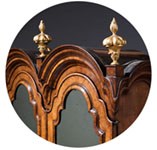17th Century Hague Clock Signed by Pieter Visbagh
CIRCA 1675
Price Enquiry
Follow Us
17th Century Hague Clock Signed by Pieter Visbagh, circa 1675
Unusually small Hague clock made c. 1675 by Pieter Visbagh, who was apprenticed by Salomon Coster. The latter made the first pendulum clock according to the instructions of Christiaan Huygens, the internationally renowned scientist who developed the idea of applying a pendulum to a clock movement.
The delicate ebony-veneered case has a moulded broken arch pediment, whilst the door is flanked by plain half round Doric capital-capped columns on high bases. A traditional star adorns the internal face of the case surrounded by well-chosen cuts of olive in a parquetry fashion. This design of star was also popular in England around this time and was almost certainly introduce by the Huguenots.
The two-day movement is driven by a compact single barrel. The going train has its original verge escapement with a silk suspended pendulum between cycloidal cheeks, also a design by Huygens to improve the trajectory of the pendulum bob. The sides of the backcock are richly pierced and engraved. The striking train is regulated by an external pierced countwheel with a blued steel backing on the backplate to create a lovely contrast; the last hour struck is indicated by Arabic numerals. The striking, which has elaborately pierced striking gates, sounds the hours on a bell inside the case, which has a sound fret in the bottom. The backplate is signed at the bottom by the maker: Pieter Visbagh Fecit Haghe.
The velvet-covered brass dial is hinged on the left hand side, giving access to the movement, which has an almost bronze-like patina caused by age. It has a fine skeletonised gilt-brass Roman chaptering with half hour and Arabic minute divisions. The time is indicated by a fine pair of original gilt brass hands, the hour hand delicately pierced. Below is a shaped and chased signature cartouche, consisting of a crowned coat of arms held by two putti. It bears the maker’s name: P. Visbag Haghe. It is hinged at the top and upon lifting a rectangular hole is revealed through which the pendulum can be activated.
Condition
Good, wear consistent with age and use
Dimensions
H 13.78 in. x W 9.45 in. x D 5.12 in.
H 35 cm x W 24 cm x D 13 cm
PREVIOUSLY SOLD

Louis XV Style French Lantern
A superb large French brass lantern of Louis XV style, 19th century. The five light chandelier within a cylindrical lantern cast with scrolling acanthus, shells and vase-shaped finials with serpentine glazed panels, fitted for electricity.
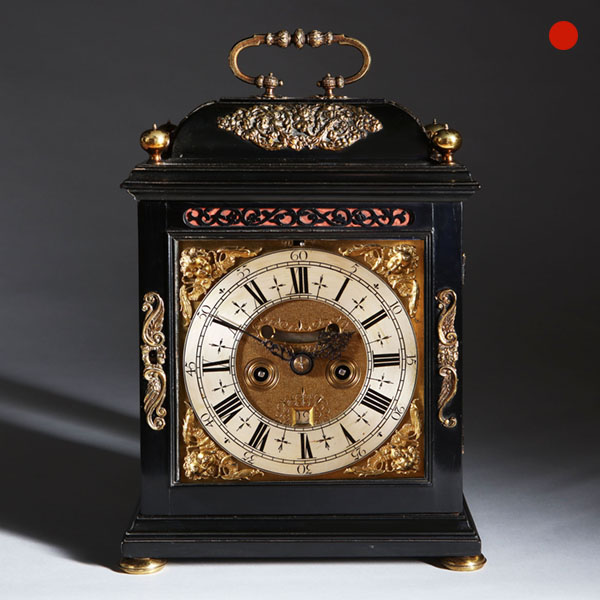
William and Mary Ebony Veneered Bracket Clock by Johnathan Lowndes
The ebony-veneered case has a so-called domed top, a design which became popular in the Charles II period (from 1675 onwards). The case is adorned with repousse brass ornaments and rests on gilt-brass bun feet. It is surmounted by a brass carrying handle of typical shape.
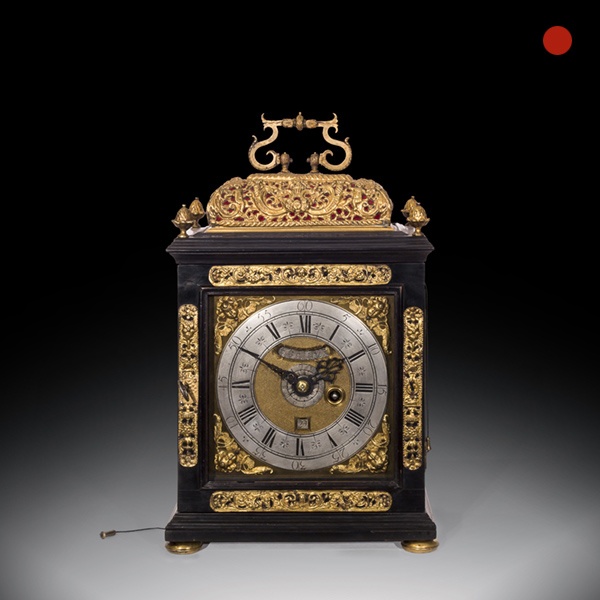
17th-Century Ebony Veneered Table Clock with Alarm and Pull Quarter Repeat
A magnificent sprung driven table clock by respected London maker George Etherington. The late 17th century, ebony- veneered table clock with alarm and pull quarter repeat on two bells, signed on the chapter ring Etherington London, and on the backplate Geo Etherington LONDON, c. 1695-1700.
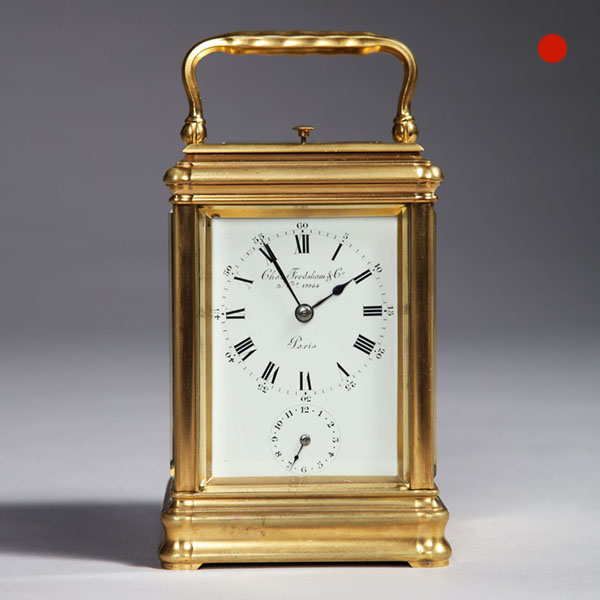
19th-Century Carriage Clock signed Charles Frodsham, London
The so-called gorge case has its original gilding. It has bevelled glass panels on all sides so that the movement is entirely visible and is surmounted by a shaped carrying handle. The white enamel dial has a Roman chapter ring, with Arabic five-minute and minute divisions.
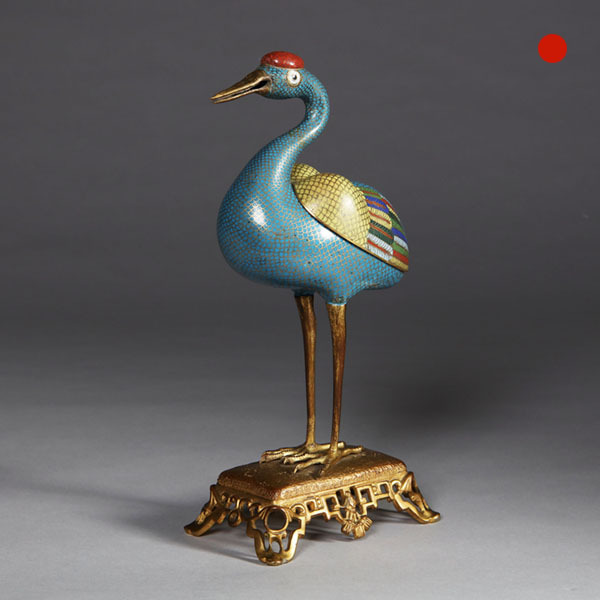
Chinese Cloisonne Enamel Censer Modelled as a Crane 18/19th Century Qing Dynasty
The characterful and charming 18/19th-century cloisonne enamel censer, is modelled as a crane with straight gilt-metal legs, realistically detailed feet and claws, standing on a detailed gilt base. The neck gracefully curved above the plump hollow body brightly enamelled in turquoise.
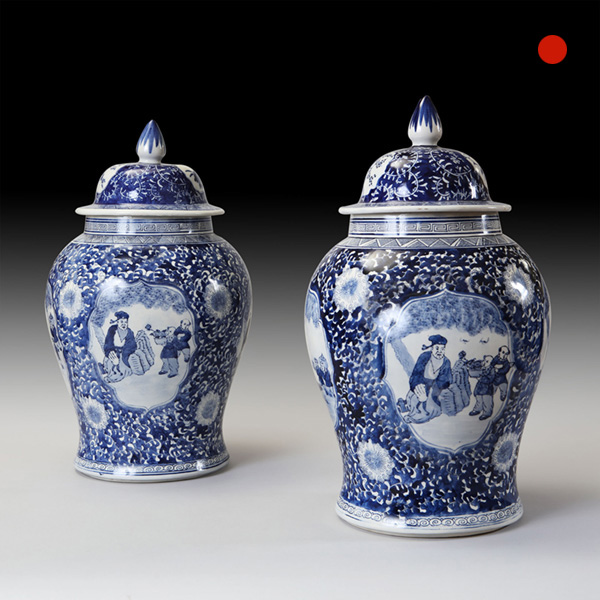
Large Pair of Blue and White Baluster Vases and Covers
Each jar is decorated with four reserves on a ground of scrolling flowers. The domed covers are surmounted by a finial. LATE QING DYNASTY (1644-1911).

Louis XV Style French Lantern
A superb large French brass lantern of Louis XV style, 19th century. The five light chandelier within a cylindrical lantern cast with scrolling acanthus, shells and vase-shaped finials with serpentine glazed panels, fitted for electricity.

William and Mary Ebony Veneered Bracket Clock by Johnathan Lowndes
The ebony-veneered case has a so-called domed top, a design which became popular in the Charles II period (from 1675 onwards). The case is adorned with repousse brass ornaments and rests on gilt-brass bun feet. It is surmounted by a brass carrying handle of typical shape.

17th-Century Ebony Veneered Table Clock with Alarm and Pull Quarter Repeat
A magnificent sprung driven table clock by respected London maker George Etherington. The late 17th century, ebony- veneered table clock with alarm and pull quarter repeat on two bells, signed on the chapter ring Etherington London, and on the backplate Geo Etherington LONDON, c. 1695-1700.

19th-Century Carriage Clock signed Charles Frodsham, London
The so-called gorge case has its original gilding. It has bevelled glass panels on all sides so that the movement is entirely visible and is surmounted by a shaped carrying handle. The white enamel dial has a Roman chapter ring, with Arabic five-minute and minute divisions.

Chinese Cloisonne Enamel Censer Modelled as a Crane 18/19th Century Qing Dynasty
The characterful and charming 18/19th-century cloisonne enamel censer, is modelled as a crane with straight gilt-metal legs, realistically detailed feet and claws, standing on a detailed gilt base. The neck gracefully curved above the plump hollow body brightly enamelled in turquoise.

Large Pair of Blue and White Baluster Vases and Covers
Each jar is decorated with four reserves on a ground of scrolling flowers. The domed covers are surmounted by a finial. LATE QING DYNASTY (1644-1911).
YOU MAY ALSO LIKE
No Results Found
The page you requested could not be found. Try refining your search, or use the navigation above to locate the post.
No Results Found
The page you requested could not be found. Try refining your search, or use the navigation above to locate the post.
